A bright decoration in your beds - tomato "Kakadu f1": reviews and secrets of getting a bountiful harvest
To keep their tomatoes on the table all summer and autumn, gardeners plant tomatoes with different ripening periods. In this case, the first fruits will appear at the end of June, and the last at the end of September. In addition, gardeners are looking for varieties that will delight with high yields and excellent taste, without being demanding in terms of care.
While there are many high-yielding mid-ripening varieties on the market, early-ripening tomatoes are much less common. And not all of them have a sweet taste and are easy to grow. One of the few early-ripening hybrids that will meet the wildest expectations of gardeners is the Kakadu tomato. Why is he so attractive - read on.
General description of Kakadu
Kakadu is a tomato hybrid. This is indicated by the mark f1. This means that the crop was developed by crossing two different tomato varieties.
The tomato is not included in the Russian register. Despite this, it is produced by domestic companies.
Features of the hybrid
Kakadu berries are a deep red color. Often there are small orange spots on the skin.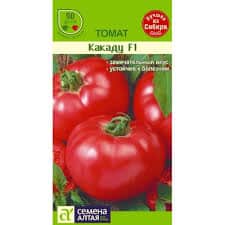
These tomatoes taste sweet with a slight sourness. Pronounced tomato aroma. The taste of these tomatoes will not disappoint even the most demanding gourmets.
This is one of the few early-ripening hybrids, which is characterized by ease of cultivation, excellent taste and long shelf life. They retain their presentation and do not deteriorate within a month.
In gastronomic terms, the variety is universal.It is used for fresh consumption and canning as a whole. Kakadu is also suitable for making juices and sauces.
One of the main positive features of Kakadu for gardeners in our country is its resistance to cold weather and ease of care. The hybrid is not tall, so it does not require such careful formation and frequent stepsons, as indeterminate varieties.
Has immunity to the most dangerous tomato diseases. Thanks to its early ripeness, it does not have time to contract late blight.
Characteristics
The characteristics of the Cockatoo hybrid are optimal for the conditions of our country. With their ease of care and resistance to cold weather, they produce a rich harvest with a good taste.
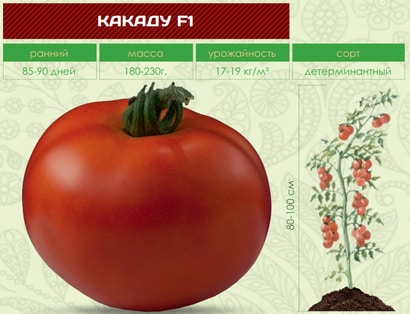
Description of the Cockatoo hybrid:
| Parameter | Indicators |
| Bush type | Determinant hybrid. They stop growing after the appearance of the superior ovary. The height of the bush varies between 70-90 cm. The stems are strong and powerful with an average amount of greenery. The leaves are rich green, large, without pubescence. The inflorescences are simple. The first is laid after 6-7 leaves. The next ones every 2 sheets. Tomatoes are formed in clusters, each of which grows 6 berries. |
| Growing method | Mainly grown in open ground. In cold regions, cultivation in greenhouses and film shelters is possible. |
| Productivity | High. From 1 sq. m harvest about 19 kg of tomatoes. For 1 sq. m planted 5 Kakadu bushes. |
| Fruit | Average. One berry weighs from 180 to 230 g. The tomatoes are bright red inside and out, without a green spot at the base. There may be orange spots on the skin. Unripe fruits are green with a yellow spot. The shape of the berries is round, slightly flattened, with pronounced ribbing at the base.The taste is sweet, with a slight sourness. There is a lot of pulp, but it is juicy. There are from 4 to 6 seed chambers in the berries. |
| Transportability | High. The skin of the fruit is smooth and durable. This allows them to be transported over long distances and stored for a long time. |
| Ripening time | Early ripening variety. The first fruits ripen 3 months after sowing the seeds. |
| Disease resistance | Immunity to fusarium, tobacco mosaic, alternaria. Not sick late blight. |
Growing seedlings
Tomato seeds are sown for seedlings 50 days before they are planted in a permanent place. The exact sowing time depends on the climatic conditions of the region in which the gardener lives:
- in the south of our country, seeds are sown at the end of February;
- in the northern part of Russia, seedlings begin to be grown in late May or early April;
- in the central regions, seeds are sown in the second half of March.
Gardeners are advised to look at the lunar calendar before sowing seeds. It is believed that seedlings planted on the correct lunar day will grow healthy and strong.
Processing of planting material
Before sowing the seeds, they need to be processed. This will increase the germination rate of planting material. Disinfection will prevent plant diseases in the future.
Preparing seeds for planting:
- Before purchasing, you need to check the expiration dates of the seeds on the packaging. There should also be information about whether the seeds were treated in the factory.
- To test the seeds for their ability to sprout, they are soaked in salted water for half an hour. Add a teaspoon of salt to a glass of warm water. Floated specimens are collected and thrown away. Those seeds that have sunk to the bottom are washed with running water.
- Then the seeds are disinfected. To do this, they are soaked in a light pink solution of potassium permanganate, in a soda solution, in aloe juice or “Fitosporin”.
- The last treatment involves stimulating the growth of planting material. To do this, pieces of gauze are moistened in a special solution. After this, the seeds are wrapped in them. The tissue with the seeds is placed in a saucer, which is covered with film and placed in a warm place. As a solution to stimulate growth, purchased products (Epin) or homemade preparations (aloe juice diluted in equal proportions with water) are used.
Selection of containers and soil
In most cases, Kakadu tomatoes are planted in the usual way. To do this, seeds are sown in spacious containers. Use special boxes and trays or improvised materials. Disposable deep plates, cake packaging, and semi-finished food trays are suitable for sowing seeds.
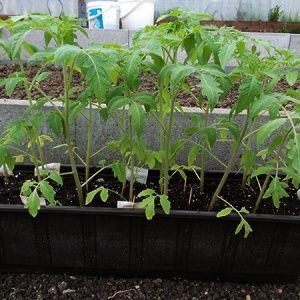 When the seedlings grow, they are planted in separate containers. Its volume must be at least 300 ml. For these purposes, special plastic and peat pots, disposable cups and cut-off bottles are used.
When the seedlings grow, they are planted in separate containers. Its volume must be at least 300 ml. For these purposes, special plastic and peat pots, disposable cups and cut-off bottles are used.
Containers for growing seedlings need to be treated. To do this, they are soaked in a dark pink solution of potassium permanganate.
Soil for tomato seedlings is sold in gardening stores. They also prepare it themselves.
To prepare the soil for seedlings, peat, turf and humus are mixed in equal proportions. Add half a portion of sawdust, sand or braided substrate to the resulting mixture. Take a glass of ash and a matchbox of superphosphate onto a bucket of soil mixture.
The soil needs to be processed. It is watered with a weak solution of potassium permanganate or boiling water.
Planting seeds in different ways
There are several ways to grow seedlings. The list contains the most common of them:
- Soil is poured into the box so that its layer ends 2 cm from the edge. Seeds are laid out in rows on the soil. The distance between the rows should be 2 cm, and between the seeds 1.5 cm. The soil is generously moistened with a spray bottle, after which the container is covered with film and placed in a warm place. When 2 true leaves appear on the plants, they are transplanted into individual pots.
- They grow seedlings without soil. To do this, place several layers of paper or napkins at the bottom of the container. A little warm water is poured on them and the seeds are laid out. Another layer of paper is placed on top, which is also moistened with water. The containers are covered with film and placed in a warm place. When the seeds germinate and the first cotyledon leaves appear, they are planted in separate containers.
- Another popular method is sowing seeds in peat tablets.. To do this, you need to prepare the tablets themselves. They are placed in deep containers with the hole facing down and filled with water. When the water is absorbed and the workpieces swell, add a little more water. The tablets are removed from the container and turned over with the hole facing up, a hole is made in the peat with a toothpick and a seed is placed there. Tablets with seeds are placed in one deep container, covered with film and put in a warm place.
Seedling care
It is important to provide the seedlings with regular care. The list shows the basic rules for caring for tomatoes:
- The seedlings are watered as the soil dries. Before the seeds germinate, this is done from a spray bottle; when the first shoots appear, from a pipette or syringe; after picking, a watering can is used. This is done to prevent water from getting on the greenery of the plants. Use only water at room temperature.
- When the seeds germinate, the boxes with seedlings are moved to a well-lit place. The film is removed a week after seed germination.
- After the true leaves appear, the plants are planted in individual containers. The roots are not pinched.
- After picking, the plants are not watered for a week. Ten days after this procedure, the tomatoes are fed for the first time.
- Seedlings are fed three times. They alternate between complex mineral compositions and vermicompost. Fertilizers are applied a second time 14 days after the first feeding.
- 14 days before planting seedlings in open ground, they begin to harden them. To do this, the tomatoes are taken out into the fresh air every day. The first time for half an hour, then the time is doubled. Gradually, the length of time the plants stay outside is increased to 16 hours.
Growing tomatoes
Tomatoes are planted in open ground when the soil warms up. For early ripening hybrids, timely picking to a permanent place is especially important. If the seedlings are left too long, ovaries will appear on them, which will significantly complicate their further cultivation.
The time for growing tomatoes depends on the region in which the gardener lives:
- in the south - at the end of April;
- in the central part of Russia - in the second half of May;
- in the northern regions - in early June.
Planting seedlings in a permanent place
The beds for tomatoes need to be prepared in advance. In autumn, the soil is dug up and cleared of weeds. It is enriched with mullein, chicken droppings and ash. To reduce the acidity of the soil, it is mixed with lime.
In the spring, the beds are dug up again and cleared of plant roots.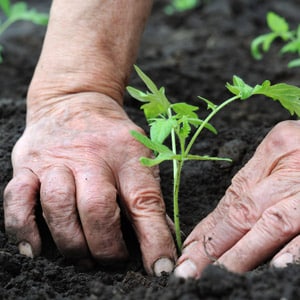
The holes are dug in rows in a checkerboard pattern. Planting pattern 50x40. For 1 sq. m plant no more than 5 plants. It is not recommended to thicken plantings; this will lead to a decrease in yield.
3 days before planting tomatoes in a permanent place, they are watered and fed. Directly when picking, the plants are removed from their pots along with a lump of earth.
Seedlings are planted in holes. The root system is formed towards the center.
Water is poured into the holes. After this, they are sprinkled with soil. The next time the tomatoes are watered after 10 days.
Caring for Kakadu tomato
Kakadu tomatoes, despite their short stature, need to be formed. During this procedure, 2-3 stems are left. The more stems, the later the harvest will appear. The size of the fruit also depends on this factor.
The tomato produces few shoots, but you still have to remove the excess. The yellowed and lower leaves are plucked from the bush. This procedure is carried out early in the morning or in the evening.
Tie up The cockatoo needs it. Otherwise, its stem will break under the weight of the fruit. A wooden support or trellis is used for gartering.
Tomatoes are watered as the soil dries. Watering should be plentiful, but infrequent. One plant requires 1 to 3 liters of water. On the days of pinching, the soil is not moistened.
The soil must be loosened after each glaze and rain. Otherwise, a crust will form on the ground, preventing root air exchange and moisture evaporation.
During the season, tomatoes are fed 3 to 4 times. The frequency of fertilizing depends on the condition of the plants.
Root supplements can be mineral or organic. Experienced gardeners advise alternating these compositions. Complex fertilizers are usually bought in the store, and diluted mullein, chicken droppings or humus are used as organic ones.
Gardener mistakes
When growing tomatoes, beginning gardeners often encounter some difficulties. Typically, this is the result of mistakes they make:
- Garter of tomatoes with natural fabric. From moisture, such material begins to rot, leading to decomposition of the stem. To prevent this from happening, use synthetic material.
- Hope for self-pollination. Tomatoes are a self-pollinating crop, but without the help of gardeners, the yield will be low. When flowers appear, it is recommended to gently shake the bushes daily.
- Applying excessive amounts of fertilizing. As a result, the green mass develops, and the fruits become sparse and small.
- Lack of fertilizers. This is fraught with withering of the leaves and failure to form ovaries.
- Refusal of hilling. If roots have formed on the stem of the plant, they must be covered with soil. Otherwise, the plants will wither and die.
Diseases and pests
The cockatoo is immune to the most common tomato diseases. He does not suffer from late blight and tobacco mosaic.
However, preventive measures cannot be neglected:
- It is necessary to disinfect not only the soil, seeds and containers for growing seedlings, but also garden tools.
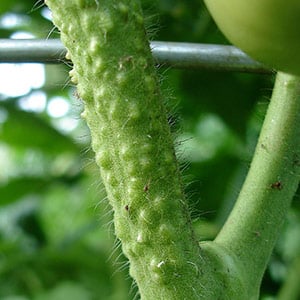
- Be sure to remove the remains of crops that previously grew in tomato beds. They may contain pathogens.
- Weed your tomato beds regularly. Weeds contribute to the development of fungal and viral infections and also attract pests.
- Follow the rules of watering and planting. It is improper soil moisture that creates ideal conditions for the development of infections.
- Protect plants from pests. Treat tomato bushes with soap solution, infusion of dandelion and celandine. Collect large beetles by hand. Egg shells will help get rid of mole crickets.
Features of growing tomatoes in open and protected ground
The Kakadu tomato is mainly grown in open ground. This hybrid is immune to cold weather.
In open ground, the first two weeks after planting, tomatoes are covered with film at night. This will protect them from frost.
To prevent the roots of tomatoes from freezing, the beds are mulched. For this purpose, use hay, straw or burlap. In some cases, it is possible to use film.
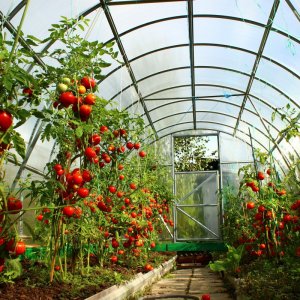 When growing tomatoes in a greenhouse, the walls of the room are treated with a disinfectant solution. To maintain optimal humidity in the greenhouse, it is regularly ventilated by opening the windows.
When growing tomatoes in a greenhouse, the walls of the room are treated with a disinfectant solution. To maintain optimal humidity in the greenhouse, it is regularly ventilated by opening the windows.
In protected soil, it is especially important to help pollinate tomatoes. To do this, the bushes are shaken periodically.
Harvesting and application
The first Kakadu fruits ripen at the end of June. They are collected in tassels or individually, depending on how well they ripen.
Gardeners advise letting ripe berries hang on the bush for a while. This will improve their taste.
When harvesting, it is important to leave the stem on the tomatoes. It will increase the shelf life of the crop.
Their Kakadu tomatoes make delicious salads and an excellent tomato variety.
Pros and cons of Kakadu
Benefits of Kakadu:
- immunity to tomato diseases;
- early ripeness;
- high transportability;
- possibility of long-term storage;
- resistance to cold weather;
- pronounced tomato taste;
- ease of care.
No shortcomings were found in Kakadu.
Reviews about the hybrid
Reviews from gardeners about Kakadu are positive. All those who grew it note its taste and high yield.
Andrey Dubov, Moscow: “I’ve been raising Kakadu for several years now. My favorite hybrid. It has an excellent taste, and the fruits are red and beautiful, as in the photo. I plant it in open ground. Yield indicators are high. From 1 sq.I’m collecting several buckets of fruit.”
Ksenia Zubova, Lipetsk: “I planted the Kakadu tomato for the first time last year on the advice of a friend. Already in June I was able to taste the first fruits. They are bright red, sweet and juicy. What you need for salads. We also liked it in canned form.”
Conclusion
Kakadu is a tomato hybrid that has no disadvantages. It is an early ripening variety and produces a rich harvest. The taste of its bright red varieties is sweet and pleasant. Due to its resistance to cold weather, it is suitable for cultivation in most regions of our country and is considered an excellent option for beginners and experienced gardeners.